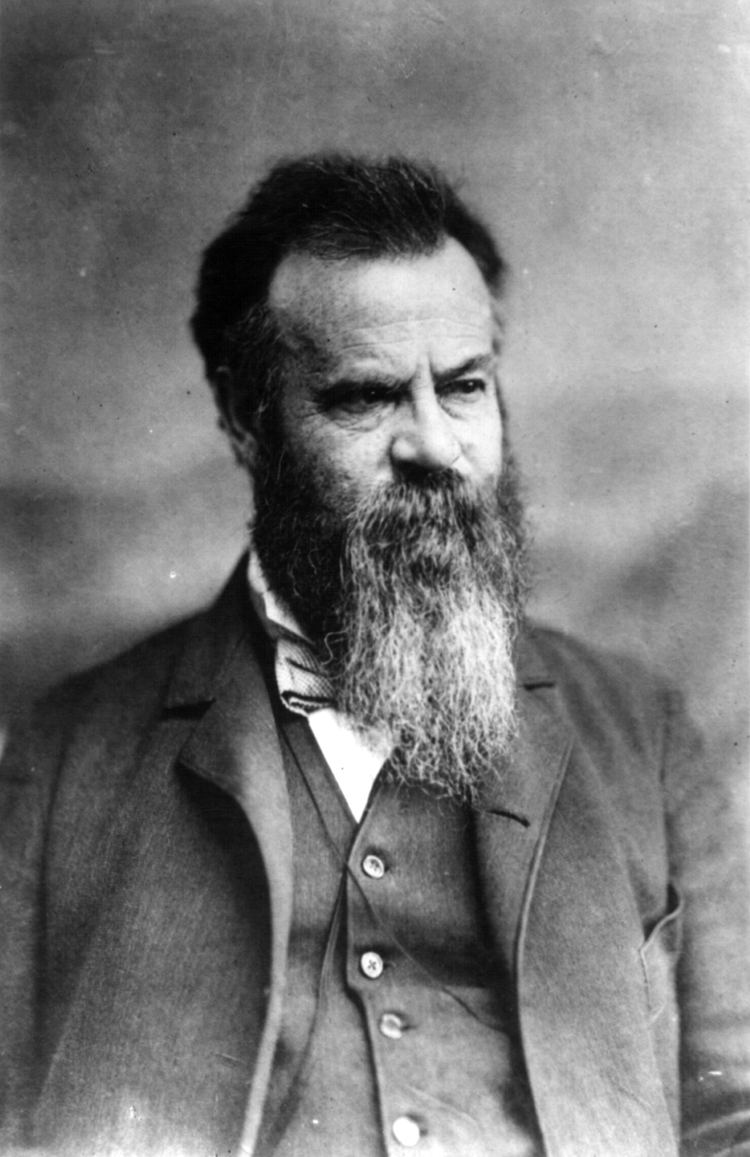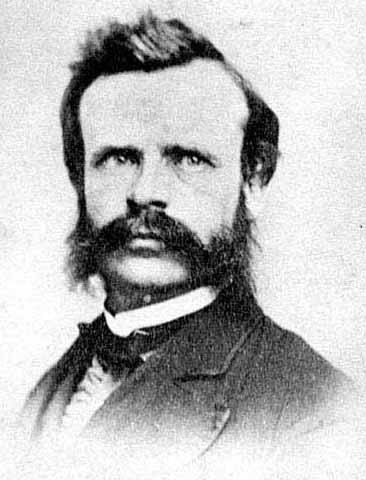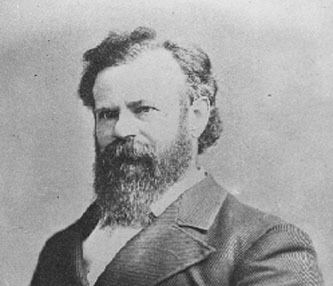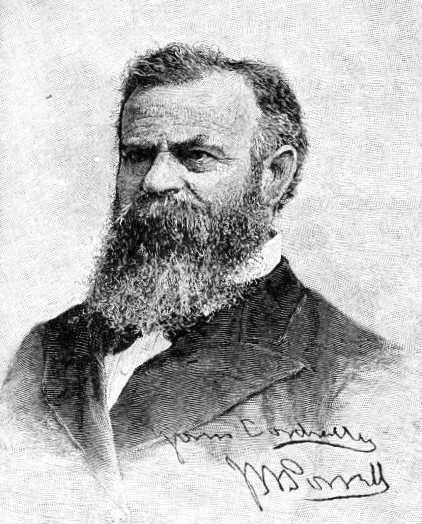Nationality American Name John Powell | Role Soldier Ex-spouse Emma Powell | |
 | ||
Died September 23, 1902, North Haven, Maine, United States Books The Exploration of the Col, Canyons of the Colorado, The arid lands, Seeing Things Whole, First Through the Grand Similar People Garcia Lopez de Cardenas, Wallace Stegner, John Wesley, Jesse Walter Fewkes, Horace Kephart | ||
National geographic live john wesley powell from the depths of the grand canyon
John Wesley "Wes" Powell (March 24, 1834 – September 23, 1902) was a U.S. soldier, geologist, explorer of the American West, professor at Illinois Wesleyan University, and director of major scientific and cultural institutions. He is famous for the 1869 Powell Geographic Expedition, a three-month river trip down the Green and Colorado rivers, including the first known passage by persons of European descent through the Grand Canyon.
Contents
- National geographic live john wesley powell from the depths of the grand canyon
- John wesley powell in the grand canyon
- Early life
- Education
- Civil war and aftermath
- Expeditions
- After the Colorado
- Views and ideas
- Legacy
- References

Powell served as second director of the U.S. Geological Survey (1881–1894) and proposed, for development of the arid West, policies that were prescient for his accurate evaluation of conditions. He became the first director of the Bureau of Ethnology at the Smithsonian Institution during his service as director of the U.S. Geological Survey, where he supported linguistic and sociological research and publications.

John wesley powell in the grand canyon
Early life

Powell was born in Mount Morris, New York, in 1834, the son of Joseph and Mary Powell. His father, a poor itinerant preacher, had emigrated to the U.S. from Shrewsbury, England, in 1830. His family moved westward to Jackson, Ohio, then Walworth County, Wisconsin, before settling in rural Boone County, Illinois.

As a young man he undertook a series of adventures through the Mississippi River valley. In 1855, he spent four months walking across Wisconsin. During 1856, he rowed the Mississippi from St. Anthony, Minnesota, to the sea. In 1857, he rowed down the Ohio River from Pittsburgh to the Mississippi River, traveling north to reach St. Louis. In 1858 he rowed down the Illinois River, then up the Mississippi and the Des Moines River to central Iowa. At age 25, he was elected in 1859 to the Illinois Natural History Society.
Education
Powell studied at Illinois College, Illinois Institute (which would later become Wheaton College), and Oberlin College, over a period of seven years while teaching, but was unable to attain his degree. During his studies Powell acquired a knowledge of Ancient Greek and Latin. Powell had a restless nature and a deep interest in the natural sciences. This desire to learn about natural sciences was against the wishes of his father, yet Powell was still determined to do so. In 1860 when Powell was on a lecture tour he decided that the Civil War was inevitable; he decided to study military science and engineering to prepare himself for the imminent conflict.
Civil war and aftermath
Powell's loyalties remained with the Union and the cause of abolishing slavery. On May 8, 1861, he enlisted at Hennepin, Illinois, as a private in the 20th Illinois Infantry. He was described as "age 27, height 5' 6-1/2" tall, light complected, gray eyes, auburn hair, occupation—teacher." He was elected sergeant-major of the regiment, and when the 20th Illinois was mustered into the Federal service a month later, Powell was commissioned a second lieutenant. He enlisted in the Union Army as a cartographer, topographer and military engineer.
During the Civil War, he served first with the 20th Illinois Volunteers. While stationed at Cape Girardeau, Missouri, he recruited an artillery company that became Battery "F" of the 2nd Illinois Light Artillery with Powell as captain. On November 28, 1861, Powell took a brief leave to marry the former Emma Dean. At the Battle of Shiloh, he lost most of his right arm when struck by a minie ball while in the process of giving the order to fire. The raw nerve endings in his arm would continue to cause him pain for the rest of his life.
Despite the loss of an arm, he returned to the Army and was present at Champion Hill, Big Black River Bridge on the Big Black River and in the siege of Vicksburg. Always the geologist he took to studying rocks while in the trenches at Vicksburg. He was made a major and commanded an artillery brigade with the 17th Army Corps during the Atlanta Campaign. After the fall of Atlanta he was transferred to George H. Thomas' army and participated in the battle of Nashville. At the end of the war he was made a brevet lieutenant colonel, but preferred to use the title of "Major".
After leaving the Army, Powell took the post of professor of geology at Illinois Wesleyan University. He also lectured at Illinois State Normal University for most of his career. Powell helped expand the collections of the Museum of the Illinois State Natural History Society, where he served as curator. He declined a permanent appointment in favor of exploration of the American West.
Expeditions
After 1867, Powell led a series of expeditions into the Rocky Mountains and around the Green and Colorado rivers. One of these expeditions was with his students and his wife, to collect specimens all over Colorado. Powell, William Byers, and five other men were the first white men to climb Longs Peak in Colorado in 1868.
In 1869, he set out to explore the Colorado River and the Grand Canyon. Gathering nine men, four boats and food for 10 months, he set out from Green River, Wyoming, on May 24. Passing through dangerous rapids, the group passed down the Green River to its confluence with the Colorado River (then also known as the Grand River upriver from the junction), near present-day Moab, Utah, and completed the journey on August 30, 1869.
Members of the first Powell expedition:
The expedition's route traveled through the Utah canyons of the Colorado River, which Powell described in his published diary as having
". . . wonderful features—carved walls, royal arches, glens, alcove gulches, mounds and monuments. From which of these features shall we select a name? We decide to call it Glen Canyon."
One man (Goodman) quit after the first month, and another three (Dunn and the Howland brothers) left at Separation Canyon in the third. This was just two days before the group reached the mouth of the Virgin River on August 30, after traversing almost 930 mi (1,500 km). The latter three disappeared; some historians have speculated they were killed by the Shivwitz band of the Northern Paiute.
Powell retraced part of the 1869 route in 1871–1872 with another expedition that traveled the Colorado River from Green River, Wyoming to Kanab Creek in the Grand Canyon. This trip resulted in photographs (by John K. Hillers), an accurate map and various papers. At least one Powell scholar, Otis R. Marston, noted the maps produced from the survey were impressionistic rather than precise. In planning this expedition, he employed the services of Jacob Hamblin, a Mormon missionary in southern Utah and northern Arizona, who had cultivated excellent relationships with Native Americans. Before setting out, Powell used Hamblin as a negotiator to ensure the safety of his expedition from local Indian groups.
After the Colorado
In 1874, the intellectual gatherings Powell hosted in his home were formalized as the Cosmos Club. The club has continued, with members elected to the club for their contributions to scholarship and civic activism.
In 1881, Powell was appointed the second director of the U.S. Geological Survey, a post he held until his resignation in 1894, being replaced by Charles Walcott. He was also the director of the Bureau of Ethnology at the Smithsonian Institution until his death. Under his leadership, the Smithsonian published an influential classification of North American Indian languages.
In 1875, Powell published a book based on his explorations of the Colorado, originally titled Report of the Exploration of the Columbia River of the West and Its Tributaries. It was revised and reissued in 1895 as The Exploration of the Colorado River and Its Canyons.
In 1898, Powell was elected a member of the American Antiquarian Society
In the early 1900s the journals of the crew began to be published starting with Dellenbaugh's "A Canyon Voyage" in 1908, followed by the Thompson diary in 1939. Finally Bishop, Steward, W. C. Powell, and Jones' diaries were all published in 1947. These diaries made it clear Powell's writings contained some exaggerations and recounted activities that occurred on the second river trip as if they occurred on the first. They also revealed Powell used a life jacket while the other men did not have one.
Views and ideas
As an ethnologist and early anthropologist, Powell was a follower of Lewis Henry Morgan. He classified human societies into "savagery," "barbarism" and "civilization". Powell's criteria were based on consideration of adoption of technology, family and social organization, property relations, and intellectual development. In his view, all societies were to progress toward civilization. Powell is credited with coining the word "acculturation", first using it in an 1880 report by the U.S. Bureau of American Ethnography. In 1883, Powell defined "acculturation" as psychological changes induced by cross-cultural imitation.
Powell was a champion of land preservation and conservation. It was his conviction that part of the natural progression of society included making the best use of the resources. Powell created Illinois State University's first Museum of Anthropology and it was called the finest in all of North America at the time.
Powell' s expeditions led to his belief that the arid West was not suitable for agricultural development, except for about 2% of the lands that were near water sources. His Report on the Lands of the Arid Regions of the United States proposed irrigation systems and state boundaries based on watershed areas to avoid disagreements between states. For the remaining lands, he proposed conservation and low-density, open grazing.
The railroad companies, who owned vast tracts of lands 183,000,000 acres (740,000 km2) granted in return for building the railways, did not agree with Powell's views on land conservation. They aggressively lobbied Congress to reject Powell's policy proposals and to encourage farming instead, as they wanted to cash in on their lands. The U.S. Congress went along and developed legislation that encouraged pioneer settlement of the American West based on agricultural use of land. Politicians based their decisions on a theory of Professor Cyrus Thomas who was a protege of Horace Greeley. Thomas suggested that agricultural development of land would change climate and cause higher amounts of precipitations, claiming that "rain follows the plow", a theory which has since been largely discredited.
At an 1883 irrigation conference, Powell would prophetically remark: "Gentlemen, you are piling up a heritage of conflict and litigation over water rights, for there is not sufficient water to supply the land." Powell's recommendations for development of the West were largely ignored until after the Dust Bowl of the 1920s and 1930s, resulting in untold suffering associated with pioneer subsistence farms that failed due to insufficient rain and other.
